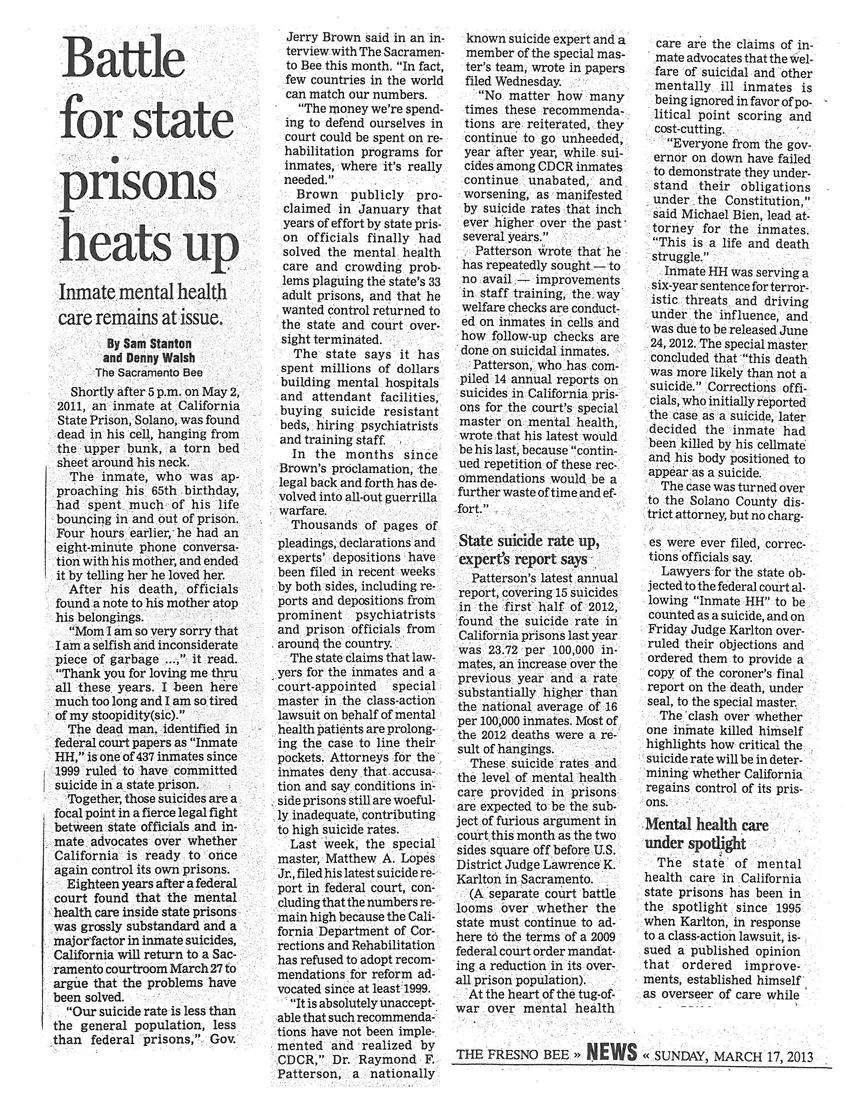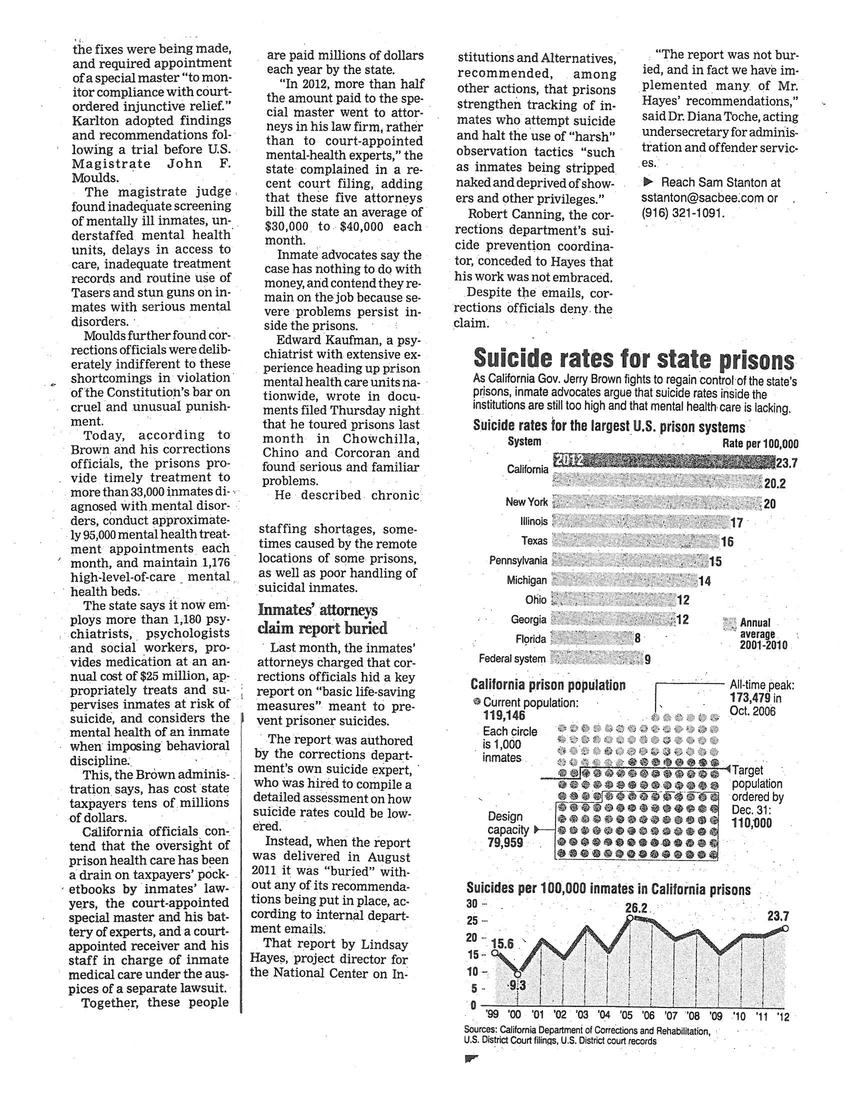
Transcription
Battle for state prisons heats up
Inmate mental health care remains at issue.
By Sam Stanton and Denny Walsh
The Sacramento Bee
Shortly after 5 p.m. on May 2, 2011, an inmate at California State Prison, Solano, was found dead in his cell, a torn bed sheet around his neck.
The inmate, who was approaching his 65th birthday, had spent much of his life bouncing in and out of prison. Four hours earlier, he had an eight-minute phone conversation with his mother, and ended it by telling her he loved her.
After his death, officials found a note to his mother atop his belongings.
"Mom I am so very sorry that I am a selfish and inconsiderate piece of garbage...", it read. "Thank you for loving me thru all these years. I been here much too long and I am so tired of my stoopidity (sic)."
The dead man, identified in federal court papers as "Inmate HH", is one of 437 inmates since 1999 ruled to have committed suicide in a state prison.
Together, those suicides are a focal point in a fierce legal fight between state officials and inmate advocates over whether California is ready to once again control its own prisons.
Eighteen years after a federal court found that the mental health care inside state prisons was grossly substandard and a major factor in inmate suicides, California will return to a Sacramento courtroom March 27 to argue that the problems have been solved.
"Our suicide rate is less than the general population, less than federal prisons", Gov. Jerry Brown said in an interview with The Sacramento Bee this month. "In fact, few countries in the world can match our numbers.
"The money we're spending to defend ourselves in court could be spent on rehabilitation programs for inmates, where it's really needed."
Brown publicly proclaimed in January that years of effort by state prison officials finally had solved the mental health care and crowding problems plaguing the state's 33 adult prisons, and that he wanted control returned to the state and court oversight terminated.
The state says it has spent millions of dollars building mental hospitals and attendant facilities, buying suicide resistant beds, hiring psychiatrists and training staff.
In the months since Brown's proclamation, the legal back and forth has devolved into all-out guerrilla warfare.
Thousands of pages of pleadings, declarations and experts' depositions have been filed in recent weeks by both sides, including reports and depositions from prominent psychiatrists and prison officials from around the country.
The state claims that lawyers for the inmates and a court-appointed special master in the class-action lawsuit on behalf of mental health patients are prolonging the case to line their pockets. Attorneys for the inmates deny that accusation and say that conditions inside prisons still are woefully inadequate, contributing to high suicide rates.
Last week, the special master, Matthew A. Lopes Jr., filed his latest suicide report in federal court, concluding that the numbers remain high because the California Department of Corrections and Rehabilitation has refused to adopt recommendations for reform advocated since at least 1999.
"It is absolutely unacceptable that such recommendations have not been implemented and realized by CDCR", Dr. Raymond F. Patterson, a nationally known suicide expert and a member of the special master's team, wrote in papers filed Wednesday.
"No matter how many times these recommendations are reiterated, they continue to go unheeded, year after year, while suicides among CDCR inmates continue unabated, and worsening, as manifested by suicide rates that inch ever higher over the past several years."
Patterson wrote that he has repeatedly sought - to no avail - improvements in staff training, the way welfare checks are conducted on inmates in cells and how follow-up checks are done on suicidal inmates.
Patterson, who has compiled 14 annual reports on suicides in California prisons for the court's special master on mental health, wrote that his latest would be his last, because continued repetition of these recommendations would be a further waste of time and effort."
State suicide rate up, expert's report says
Patterson's latest annual report, covering 15 suicides in the first half of 2012, found the suicide rate in California prisons last year was 23.72 per 100,000 inmates, an increase over the previous year and a rate substantially higher than the national average of 16 per 100,000 inmates. Most of the 2012 deaths were a result of hangings.
These suicide rates and the level of mental health care provided in prisons are expected to be the subject of furious argument in court this month as the two sides square off before the US District Judge Lawrence K. Karlton in Sacramento.
(A separate court battle looms over whether the state must continue to adhere to the terms of a 2009 federal court order mandating a reduction in its overall prison population).
At the heart of the tug-of-war over mental health care are the claims of inmate advocates that the welfare of suicidal and other mentally ill inmates is being ignored in favour of political point scoring and cost-cutting.
"Everyone from the governor on down have failed to demonstrate they understand their obligations under the Constitution," said Michael Bien, lead attorney for the inmates. "This is a life and death struggle."
Inmate HH was serving a six-year sentence for terroristic threats, and driving under the influence, and was due to be released June 24, 2013. The special master concluded that "this death was more likely than not a suicide." Corrections officials, who initially reported the case as a suicide, later decided the inmate had been killed by his cellmate and his body positioned to appear as a suicide.
The case was turned over to the Solano County district attorney, but no charges were ever filed, corrections officers say.
Lawyers for the state objected to the federal court allowing "Inmate HH" to be counted as a suicide, and on Friday Judge Karlton overruled their objections and ordered them to provide a copy of the coroner's final report on the death, under seal, to the special master.
The clash over whether one inmate killed himself highlights how critical the suicide rate will be determining whether California regains control of its prisons.
Mental health care under spotlight
The state of mental health care in California state prisons has been in the spotlight since 1995 when Karlton, in response to a class-action lawsuit, issued a published opinion that ordered improvement, established himself as an overseer of care while... [missing]... the fixes were being made, and required appointment of a special master "to monitor compliance with court-ordered injunctive relief." Karlton adopted findings and recommendations following a trial before US Magistrate John F. Moulds.
The magistrate judge found inadequate screening of mentally ill inmates, understaffed mental health units, delays in access to care, inadequate treatment records and routine use of tasers and stun guns on inmates with serious mental disorders.
Moulds further found corrections officers were deliberating indifferent to these shortcomings in violation of the constitution's bar on cruel and unusual punishment.
Today, according to Brown and his corrections officials, the prisons provide timely treatment to more than 33,000 inmates diagnosed with mental disorders, conduct approximately 95,000 mental health treatment appointments each month, and maintain 1,176 high-level-of-care mental health beds.
The state says it now employs more than 1,180 psychiatrists, psychologists and social workers, provides medication at an annual cost of $25 million, appropriately treats and supervises inmates at risk of suicide, and considers the mental health of an inmate when imposing behavioural discipline.
This, the Brown administration says, has cost state taxpayers tens of millions of dollars.
California officials contend that the oversight of prison health care had been a drain on taxpayers' pocketbooks by inmates' lawyers, the court-appointed special master and his battery of experts, and a court-appointed receiver and his staff in charge of inmate medical care under the auspices of a separate lawsuit.
Together, these people are paid millions of dollars each year by the state.
"In 2012, more than half the amount paid to the special master went to attorneys in his law firm, rather than to court-appointed mental-health experts," the state complained in a recent court filing, adding that these five attorneys bill the state an average of $30,000 to $40,000 each month.
Inmate advocates say the case has nothing to do with money, and contend they remain on the job because severe problems persist inside the prisons.
Edward Kaufman, a psychiatrist with extensive experience heading up prison mental health care units nationwide filed Thursday night that he toured prisons last month in Chowchilla, Chino and Corcoran and found serious and familiar problems.
He described chronic staffing shortages, sometimes caused by the remote locations of some prisons, as well as poor handling of suicidal inmates.
Inmates' attorneys claim report buried
Last month, the inmates' attorneys charged that corrections officials hid a key report on "basic live-saving measures" meant to prevent prison suicides.
The report was authored by the corrections department's own suicide expert, who was hired to compile a detailed assessment on how suicide rates could be lowered.
Instead, when he report was delivered in August 2011 it was "buried" without any of its recommendations being put in place, according to internal department emails.
That report by Lindsay Hayes, project director for the National Center on Institutions and Alternatives, recommended, among other actions, that prisons strengthen tracking of inmates who attempt suicide and half the use of "harsh" observation tactics "such as inmates being stripped naked and deprived of showers and other privileges."
Robert Canning, the corrections department's suicide prevention coordinator, conceded to Hayes that his work was not embraced.
Despite the emails, corrections officials deny the claim.
"The report was not buried, and in fact we have implemented many of Mr. Hayes' recommendations," said Dr. Diana Toche, acting undersecretary for administration and offender services.
- Reach Sam Stanton at sstanton@sacbee.com or (916) 321-1091
Suicide rates for state prisons
As California Gov. Jerry Brown fights to regain control of the state's prisons, inmate advocates argue that suicide rates inside the institutions are still too high and that mental health care is lacking.
[Bar chart - 'Suicide rates for the largest US prison systems]
Other posts by this author
|
2014 feb 3

|
2014 jan 23

|
2014 jan 23

|
2014 jan 13

|
2014 jan 14

|
2013 dec 1

|
More... |



Replies